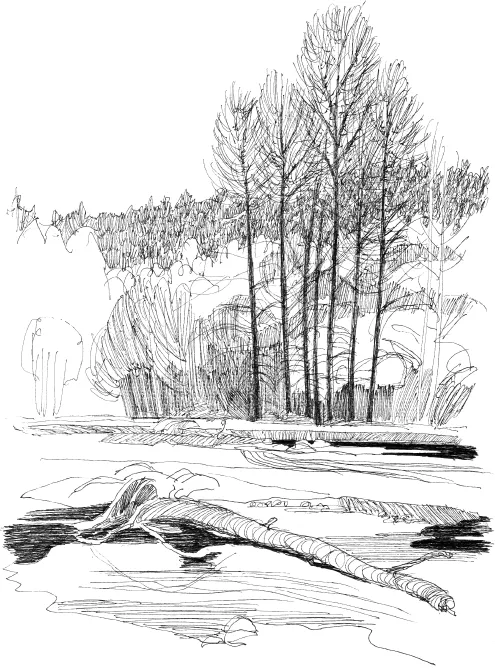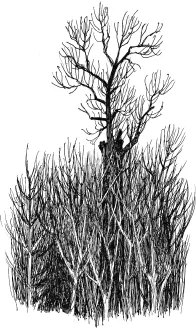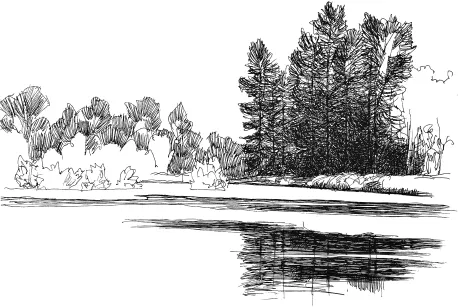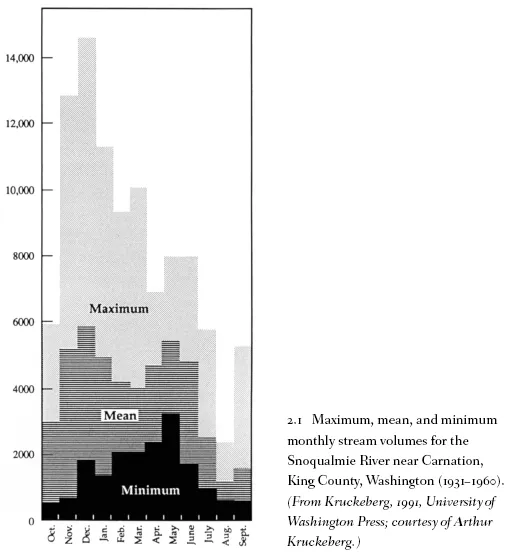![]()
PART I
The Tree and the River
The setting is a floodplain of a river on the west side of the Cascade Range, the home turf of black cottonwood. It is a fleeting turf, a temporary home in the ever-changing environment of an active river. Periodic flooding, summer drought, bank erosion, shifting sand and gravel, deposition of woody debris, and channel migration keep setting a new stage season after season, and year after year. Only trees that can seize the moment and have flexible growth and reproduction can match this fickle environment. Through its pioneering existence, cottonwood also prepares the habitat for other species to follow in the natural succession of riparian vegetation. Over the next five chapters we will follow cotton-wood through its life cycle and learn about the many mechanisms that have equipped it to find its niche under conditions that defy most other trees.
![]()
1 / THE TREE
The old cottonwood has lost its leaves during the last November storms. It stands there like the Statue of Liberty in the midst of the grove, the one remaining part of its crown reaching above the surrounding trees. Two other segments had come down in storms several years ago and are decomposing at its foot amid hazel shrubs and salmonberry. The tree is nearing the end of its upright existence; it's perhaps 130 years old but still impressive with its tall, cylindrical trunk. Even last spring it shed thousands of seed from its few live branches and sent them flying away in their cottony tufts. Some had landed on freshly deposited sand at the nearby river, the possible beginning of a new generation. In fact, the old matriarch is the last member of its age group in that forest and is now surrounded by younger bigleaf maples, some bitter cherries, and a few conifers. They have come up in the half shade of the disintegrating cottonwood stand, followers in the footsteps of the original pioneers, forest succession in full progress.
Is a tree really old at age 130? Aren't those the best years, years when life continues for centuries, in some trees even for millennia? True, but what is normal for Douglas fir or a bristlecone pine is not the rule for cottonwood or alder. Some species are sprinters, whereas others are marathon runners, and each has characteristic features that seem to be geared to its pace. Cottonwoods, as all members of the genus Populus (poplars and aspens), are early-successional pioneers, stake their claim in raw, inhospitable territory, rapidly build up expansive populations, disperse their seed in large quantities to new locations, and then yield their ground to other species. Our old matriarch is actually a black cottonwood (P. trichocarpa) native to western North America, a coastal species that ranges from Alaska to California and extends inland to the Rocky Mountains. This individual has spent its life at the foot of the Cascade Range in the floodplain of a river that drains into Puget Sound. It has experienced wet winters and dry summers, occasional windstorms, and regular floods in its early life, but fewer of them later as the river moved its channel away over the years. Why matriarch? Do trees come in males and females? Actually, in most species trees are bisexual, but in poplars and willows, members of the Family Salicaceae, the two sexes are in separate individuals. And thanks to wind pollination, this old female, last member of its local age group, was able to receive pollen from males of younger cohorts closer to the river. Thus, even with a much-reduced crown it was able to again participate in the competition for genetic representation among the youngest set of seedlings that got started this year.
Cottonwoods can be deceptive: they look older than they are. Their rapid growth builds a trunk of a size that other trees take twice as long to achieve. And among poplars, black cottonwood is the champion, regularly reaching heights of 110 to 130 feet and diameters of 25 to 30 inches within 50 to 60 years. By that time, many of the older branches have broken off and the bark begins to develop deep furrows and cracks, reminiscent of an old, weathered face. It's as if they sped up the aging process in order to become respectable. You could say it's a youth culture in reverse, namely one in substance but not appearance, living fast and getting out, a tree geared for action and adapted to change. We will see these qualities expressed in many traits as we look in greater detail into its vital profile in later chapters. Not surprisingly then, black cottonwood is less celebrated in the tree lore of the Pacific Northwest than the longer-lived conifers, especially western red-cedar, the tree of life. Which is not to say that this prominent hardwood was ignored by the native people. Its trunks were often converted to small dugouts, its wood used for smoking salmon, its bark and branches for building sweat lodges and temporary cabins. And many different uses were found for the copious gum in its fragrant buds, from applying it as glue to fix arrowheads and feathers to shafts, to waterproofing of baskets, to seeking medicinal benefits from it in preparations against baldness, sore throats, rheumatism, and tuberculosis.1 But there is no question that the cottonwoods of the western plains (P. deltoides and P. fremontii) have received considerably more attention in native mythology and poetry. In the dry expanses of the western prairies they often were the only trees to be seen and would be typically growing along watercourses and moist draws. Thus, to the weary traveler they were the welcome symbol of water, fuel, and a protected campsite—guarantor of survival.2
What attracts us to trees? Size for sure: trees are hard to ignore. And even more so if they stay there for a long time. In other words, we are drawn to the permanence of a large living structure that remains in one place, offers shade and shelter, changes only in small increments, and doesn't threaten us. Oaks, more than any other hardwoods of the temperate zone, are the embodiment of these characteristics and, as a consequence, have held symbolic value in many cultures from earliest times. Oak groves or individual trees, hundreds of years old, have served as communal sites for pagan and sacred rituals, for signing treaties, for festivities as well as for the meting out of justice.3 What exactly do oaks do to achieve such status? Oaks tend to choose well-developed, stable habitats that increase the probability for a long life. Once established, they grow slowly and invest much carbon in wood of high specific gravity and great strength, developing a solid structure that can outlast storms and snow. They also divert a considerable amount of photosynthates to form defensive chemicals that protect their biomass from fungi and insects. Finally, they delay puberty until they can afford it; it may take an oak thirty to forty years to begin sexual reproduction, by which time it will be well established and likely to have a permanent position in its forest. (In my enumeration of key features I have portrayed oaks as if they willfully chose them in order to better succeed in their struggle for existence; the reader should realize that this teleological shorthand is another way of saying that mutants with such features tended to leave more offspring in subsequent generations of oak evolution—thus making them more favored by natural selection in the long term.) In sum, oaks are just about the antithesis of poplars and willows, which are found in transitory habitats, where they grow as rapidly as possible, reproduce early and copiously, and invest just enough in their woody structure to gain dominance while expending little to preserve it. Not surprisingly then, these pioneers don't have an aura of timelessness. If anything, they are destined to share the fate of revolutionaries in history, relegated by succeeding generations to the transitory role of initiators and innovators but seemingly incapable of sustaining a lasting legacy. Yet these trees have been eminently successful for a long time and exist in large numbers in many parts of the world.
If our old matriarch may thus be barred from the club of venerated trees, it deserves an honored place nonetheless because it seems to emphasize the process rather than the product. Its fleeting existence draws attention to the ever-changing process of ecosystem evolution and reminds us of the underlying forces at work. After all, the seeming permanence of an oak, as comfortable as it makes us feel, is an illusion, a mere delay of the inevitable change to come. What drives our planet are processes, and the products are incidental and temporary. What drives our riparian ecosystem are the physical processes of river dynamics and their biological consequences. What drives the adaptation of vegetation to these dynamics are the processes of evolution through natural selection, combined with chance. Process is what deserves our attention if we want to understand how what we find in nature has come about, and how it is likely to function and change. True, a process needs something to work on, or work with. Erosion can only take place on something erodible. Evolution will only manifest itself in something evolvable, a string of DNA, a beak on a finch, a leaf on a cottonwood. So in the end we need the products, the structures by which to study the processes.
In the meantime, our old tree is impressive and inspirational in its own right. It is an ecosystem in itself. Its huge biomass has miles of roots in the ground, drawing water and nutrients from deep horizons and transporting them to the youngest twigs at great heights; it builds up the soil, is host to symbionts and epiphytes, offers roosting and nesting sites to birds, feeds countless species of invertebrates, and creates a unique microclimate for all the organisms around it. And short as its life may be in the world of trees, it will outlive us all. Who knows, perhaps it already has sent a broken branch or two downriver in its earlier years, which rooted and took hold and now exist as clonal copies along a lower reach. After all, there is the process of vegetative propagation—another process—and the tree's DNA may be perpetuated in absentia of the original carrier. In fact, we may have to revise our admiration for the towering and lasting piece of biomass in one place and recognize how equally impressive may be the existence of a successful genotype that is thriving in many disconnected individuals across the landscape. It even opens the possibility that such a genotype could be perpetuated sequentially for hundreds and hundreds of years, offering a new angle on a “short-lived” pioneering species.
![]()
2 / THE RIVER
Puget Sound dwellers will remember the Thanksgiving weekend of 1990. It had rained for five solid days, and this after some heavy snowfall in the Cascades. Rain-on-snow is a common sequence of weather conditions in the Northwest when a cold Canadian air mass is met with a moist storm front moving in from the Pacific. But this time the five-day rainfall on Cascade passes had exceeded 15 inches, with half of that occurring on November 23 alone. It led to floods of all west-side rivers and widespread inundation across the Puget Sound lowlands. What actually happened was that a loosely fallen blanket of wet snow in the mountains hadn't had time to settle and solidify before being rapidly melted by the heavy rain. The large amount of water resulting didn't have time to filter into the soil of the steep, wooded slopes of the Cascades, but rushed down as surface runoff into the creeks, streams, and rivers, raising them at the rate of one foot per hour or more and soon beyond the capacity of their channels. Our River's discharge was measured at 79,000 cubic feet per second (cfs; or 2,200 m3s), almost four times its official flood volume (20,000 cfs).1 It exceeded the previous peak flow of another November 23, in 1959, by almost 30 percent. Worst hit was the town below the confluence of the river's three forks where 4 homes were destroyed and 510 dwellings damaged. As reported in the local paper, the postmaster saw “mail floating on three feet of water” in the office and being left with “few dry stamps.”2 Governor Booth Gardner and President Bush declared King County and neighboring counties as disaster areas, eligible for state and federal relief.
Floods are natural events in the seasonal fluctuations of most rivers. They typically happen in spring and early summer, when winter snow-packs are transformed into meltwater, adding volume to the regular precipitation. However, the coastal rivers of the Puget Sound, such as the Snoqualmie—home of our cottonwood—Skykomish, Stillaguamish, Skagit, and Nooksack, have a different annual profile, as reflected in their characteristic hydrographs. Hydrographs are the conventional way of presenting data that depict a river's flow over time and are based on measurements taken by gages installed at strategic locations along a river's course. A typical hydrograph of a coastal river shows two highs in mean flow, one between November and February, the other between April and June (fig. 2.1).3 But, as can be seen, the maximum flows in winter far exceed those of spring. More importantly, they are key determinants of changes in the riverbed through erosion as well as movement of sediment and large woody debris. By contrast, minimum flows are typical from July through October, the result of the low precipitation characteristic of Northwest summers.
Rivers are part of the hydrological cycle. Water molecules rise from the ocean surface by evaporation, are transported to the land, further enriched by transpirational moisture from the vegetation, cool down and are shed as precipitation, feeding rivers and lakes, and are then transported back to the ocean again. While this is a continual process, it shows clear seasonal trends. And the seasonal cycles in temperature and water availability have in turn imprinted the cyclic life histories of living organisms. Rivers are the conduits of water and because of their movement and dynamics are for us perhaps the most alive portion of the hydrologic cycle. Lakes and ponds are resting, serene, and invite contemplation—but rivers are full of action and constant change. The foamy waves over riffles, the turbulence around boulders, the quiet flow in pools, all are visible along the same reach and catch even the untrained eye. And when the water has receded after a high flow, it leaves a telltale footprint: mounded gravel, streamlined sand, trapped organic debris, bent-over saplings, and beached logs, all manifesting the hydro-logical forces that once again have shaped the river's channel and banks, if only for the time being. Fascinating as this is even to the casual observer, it has become a rare sight in most parts of the world. As a source of fresh water and food, and as a means of transportation, rivers have been a perennial attraction for humans, and as a consequence most of them have become stripped of their vegetation, dammed, channeled, fouled, and irreversibly turned into sterile conduits. In the many recent efforts worldwide to undo some of this damage, interest has been reawakened in better understanding riverine dynamics, untrammeled by human interference. As we will see, this also helps us better understand cottonwood and its life cycle.
In his seminal book, A View of the River, Luna Leopold has offered a masterly overview of rivers and their underlying processes.4 Continual change in a probabilistic manner may be a lapidary way of summarizing these processes. But that would skip some of the elegant principles at work at the intersection of hydraulics and geology. Physicists have been known to get excited about the beauty of an equation, but even those of us in the biological end of the natural sciences admire the aesthetics of patterns brought about by the forces of fluid dynamics on erosive substrates. Who wouldn't be fascinated by the repetitive meanders rivers carve across their floodplain—named after the Maiandros River (now Menderes) in western Turkey—the unmistakable signature of a free-flowing river anywhere in the world (fig. 2.2)? Would fly-fishers be drawn to a stream that stretched out for a mile in a straight line?
How do meanders arise, and what forces maintain them? Careful and detailed measurements of rivers at varied flow levels have largely clarified the process. Let's assume that a stream runs in a straight line, both in planar view and in profile. Its bed is composed of a heterogeneous mix of particles of different sizes moving at different speeds and interacting with each other. This results in an uneven distribution of particles along the channel, bunching them up in bars or riffles, followed by pools with lesser concentrations of particles (similar to the clumping effect of vehicles moving on a freeway). These bars tend to deflect the flowing water toward a bank, and with this slight departure from the straight line a proto-meander has been initiated. What follows is the systematic accentuation of the curve through the higher flow velocity of the water on the outside than on the inside of the curve. This differential is caused by the centrifugal force pushing the water outward and carving into the outer bank while the slower-moving water on the inside of the curve has less erosive power and will deposit some of its load, adding to the point bar. As banks are eroded and point bars grow in alternating sequence, meandering becomes more pronounced. The physical processes at work also result in a more or less predictable relationship between the width of a river and the size of its meanders; the radius of curvature tends to approximate 2.3 channel widths, a constant that seems to hold for meanders of all sizes, from small streams to large rivers.5
Are we robbing nature of its mystique in our drive to quantify one of its timeless forms? Isn't this an accountant's formula for turning an inspiring aesthetic into a metric and devaluing it in the process? Such are the occasional laments that our probing raises. To which we can only say that every one of these insights gained, be they qualitative or quantitative, heighten our marvel at the inner workings of natural processes and their intricacy. Realizing that the Fibonacci series helps explain the chambering of a nautilus shell as well as the arrangement of florets in a sunflower and the scales on a pine cone certainly doesn't render these patterns more mundane; in fact, if anything, it lifts them to higher levels in the pantheon of natural forms.6 Seeing meanders follow a crisp physical principle can only heighten their aesthetic appeal.
Meandering is at the heart of a river's continual change. As banks get eroded and point bars grow, the river's channel slowly migrates across the floodplain. Channel mig...





